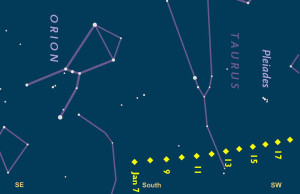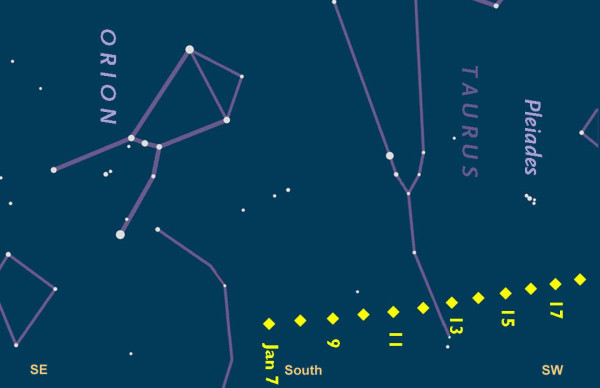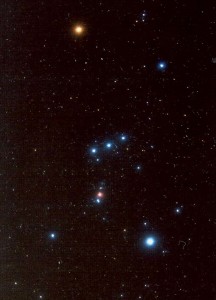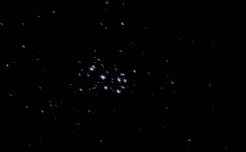 In an earlier article we talked about where to look to see comet Lovejoy in the skies in the Northern Hemisphere. As the comet continues a little each night we thought it would be worth providing an update.
In an earlier article we talked about where to look to see comet Lovejoy in the skies in the Northern Hemisphere. As the comet continues a little each night we thought it would be worth providing an update.
Last night, with clear skies near my home, I took my kids outside to see if we could spot the comet and get a good look – and we were amazed at what we saw. Here are my tips for the average person on how to find comet Lovejoy and get see it well. Unless you have really dark rural skies, I suggest at least a pair of binoculars, but a telescope is best.

The first step is to spot the Pleiades (aka the 7-sisters), as comet Lovejoy is very close to them this weekend. If you are not familiar, here is how to spot them.
 Look at the 3 belt stars of Orion (pictured here-right), perhaps one of the most easily recognizable groupings in the sky as the stars are bright and make a nearly perfect line. You will see them high up in the southern sky after around 8pm local time.
Look at the 3 belt stars of Orion (pictured here-right), perhaps one of the most easily recognizable groupings in the sky as the stars are bright and make a nearly perfect line. You will see them high up in the southern sky after around 8pm local time.
Facing south and using the stars as a guide pointing from left to right, they will point you to a small grouping of stars that look much like a “little dipper” or spoon. These are the Pleiades (pictured below).

Following that same line between Orion and the Pleiades, go about another 2-3 inches to the right to a mostly empty area you should see a very faint fuzzy blur, this is comet Lovejoy.
With a pair of binoculars, you can spot it quickly. Start with the Pleiades in view in your binoculars, just slowly pan to the right a little and you will see comet Lovejoy. Using this location as a guide, you can then aim your telescope in the same area and get a really good look at the comet.
We used a 8-in reflector telescope and in that, Lovejoy appears as a small bright star surrounded by a cloud of blue-ish green-ish gas and dust.
![Herbal Reference Substances are Key to Everyday Products <!-- AddThis Sharing Buttons above -->
<div class="addthis_toolbox addthis_default_style " addthis:url='http://newstaar.com/herbal-reference-substances-are-key-to-everyday-products/3512112/' >
<a class="addthis_button_facebook_like" fb:like:layout="button_count"></a>
<a class="addthis_button_tweet"></a>
<a class="addthis_button_pinterest_pinit"></a>
<a class="addthis_counter addthis_pill_style"></a>
</div>When it comes to quality control testing and the development of new products, Botanical Reference Materials (BRMs), also known as Herbal References are critically important. To help companies ultimately obtain all-important FDA approval, the Food and Drug Administration provides in its guidance a recommendation that […]<!-- AddThis Sharing Buttons below -->
<div class="addthis_toolbox addthis_default_style addthis_32x32_style" addthis:url='http://newstaar.com/herbal-reference-substances-are-key-to-everyday-products/3512112/' >
<a class="addthis_button_preferred_1"></a>
<a class="addthis_button_preferred_2"></a>
<a class="addthis_button_preferred_3"></a>
<a class="addthis_button_preferred_4"></a>
<a class="addthis_button_compact"></a>
<a class="addthis_counter addthis_bubble_style"></a>
</div>](http://newstaar.com/wp-content/uploads/2021/02/Achillea_millefolium_flowers-100x100.jpg)
![Quality Electrochemical Biosensors are Critical for Medical, Food and Chemical Industry <!-- AddThis Sharing Buttons above -->
<div class="addthis_toolbox addthis_default_style " addthis:url='http://newstaar.com/quality-electrochemical-biosensors-are-critical-for-medical-food-and-chemical-industry/3512086/' >
<a class="addthis_button_facebook_like" fb:like:layout="button_count"></a>
<a class="addthis_button_tweet"></a>
<a class="addthis_button_pinterest_pinit"></a>
<a class="addthis_counter addthis_pill_style"></a>
</div>A number of industries have, at their core, a need to frequent or even continuous analysis of biological media. These include the medical and pharmaceutical fields, biotech firms, and food and chemical companies. To maintain quality standards and develop new products, these industries rely heavily […]<!-- AddThis Sharing Buttons below -->
<div class="addthis_toolbox addthis_default_style addthis_32x32_style" addthis:url='http://newstaar.com/quality-electrochemical-biosensors-are-critical-for-medical-food-and-chemical-industry/3512086/' >
<a class="addthis_button_preferred_1"></a>
<a class="addthis_button_preferred_2"></a>
<a class="addthis_button_preferred_3"></a>
<a class="addthis_button_preferred_4"></a>
<a class="addthis_button_compact"></a>
<a class="addthis_counter addthis_bubble_style"></a>
</div>](http://newstaar.com/wp-content/uploads/2020/10/Electrochemical-Biosensor-100x100.jpg)
![Company Develops Industrial Mixers Well-Suited for both Fragile and Explosive Products <!-- AddThis Sharing Buttons above -->
<div class="addthis_toolbox addthis_default_style " addthis:url='http://newstaar.com/company-develops-industrial-mixers-well-suited-for-both-fragile-and-explosive-products/3512071/' >
<a class="addthis_button_facebook_like" fb:like:layout="button_count"></a>
<a class="addthis_button_tweet"></a>
<a class="addthis_button_pinterest_pinit"></a>
<a class="addthis_counter addthis_pill_style"></a>
</div>Industrial drum mixers are normally applied to blend mixes of varying viscosities such as adhesive slurries or cement. Some of these mixers have the capability of blending mixes of very different particle sizes such as fruit and ice cream, and gravel and cement slurry. The […]<!-- AddThis Sharing Buttons below -->
<div class="addthis_toolbox addthis_default_style addthis_32x32_style" addthis:url='http://newstaar.com/company-develops-industrial-mixers-well-suited-for-both-fragile-and-explosive-products/3512071/' >
<a class="addthis_button_preferred_1"></a>
<a class="addthis_button_preferred_2"></a>
<a class="addthis_button_preferred_3"></a>
<a class="addthis_button_preferred_4"></a>
<a class="addthis_button_compact"></a>
<a class="addthis_counter addthis_bubble_style"></a>
</div>](http://newstaar.com/wp-content/uploads/2020/06/bandeau-sofragir2-100x100.jpg)